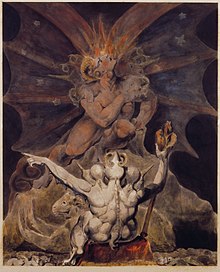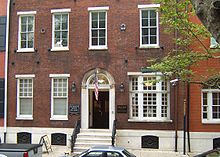Rosenbach Museum & Library
The Rosenbach Museum & Library is a museum for manuscripts, rarities and original book illustrations founded in Philadelphia in 1954 .
The museum's collection includes a. the Ulysses -Manuskript of James Joyce and drawing premature legacy of Maurice Sendak . The museum is run by the Rosenbach Foundation , which arose out of a will from the brothers Abraham and Philip Rosenbach. The Rosenbach brothers were antiquarians and art dealers; her private collection formed the basis of the museum's collection. The Rosenbach Museum is in two adjacent town houses from the mid-19th century in the area around Rittenhouse Square housed as part of the overall ensemble Delancey Place under monument protection standing.
History and museum building
The institution was founded in 1954 by a will of the brothers Abraham Rosenbach (1876–1952) and Philip Rosenbach (1863–1953). The Rosenbach brothers were successful art dealers who specialized in manuscripts, rare books and book art. Abraham Rosenbach (mostly ASW Rosenbach) is considered to be the “leading American antiquarian and manuscript dealer of the first half of the 20th century”. He dealt in Gutenberg Bibles , first editions of the Bay Psalm Book and Shakespeare's Folio . His brother Philip specialized in art and antiques, particularly English art from the 18th and early 19th centuries. The house still has its original Georgian furnishings, which were put together by Philip Rosenbach. With their art trade, Abraham and Philip Rosenbach played a key role in building up famous private libraries of patrons such as Standard Oil executive Henry Clay Folger and railroad magnate Henry E. Huntington . Most of these large collections are now open to the public, including the Folger Shakespeare Library with its Shakespeare collection and the Huntington Library with its Gutenberg Bible.
The museum was run from 1965 to 1983 by Clive Driver, who also lived in the building. His successor, Ellen Dunlap, was contacted in 1987 by a Sotheby’s employee who was offered a letter from John Adams for auction, which presumably came from the Rosenbach collection. It turned out that Clive Driver had sold the letter along with 57 other valuable manuscripts to an art dealer during his time as Rosenbach director. Clive Driver and the dealer had to return the documents; In 1989 Driver was given a suspended sentence. Dunlap was succeeded as director in 1993 by the art historian Stephen Urice, who had headed the Frederick R. Weisman Art Foundation in Los Angeles before his appointment . Urice was replaced in 1998 by the current director Derick Dreher, who was previously curator at Rosenbach. The original orientation of the Rosenbach was more like an archive or a research library than a museum: Visitors had to register in advance, there were neither fixed opening times nor public relations work, and library and archive users were expected to research and publish on the respective topic. When Dreher took office, that changed: the focus in public relations was on the more accessible work of Maurice Sendak , and the Rosenbach has also come into focus as a museum thanks to fixed opening times and larger temporary exhibitions.
The museum is located at 2010 Delancey Place in Philadelphia. Abraham Rosenbach himself lived in house number 2006. Half a block from Delancey Place (also Delancey Street ) between 20th Street and 21st Street with the house numbers 2000 to 2018 - including the building of the museum and Rosenbach's former residence - were added to the National Register of Historic Places included and thus listed . All of these buildings were constructed in 1855–1866 by architects Charles, Joseph, and James McCrea. The original owner of house number 2010 was Robert Coleman, who came from the industrial family who owned the Cornwall Iron Furnace . In 2003 the foundation also acquired the neighboring building at number 2008 and named it the Maurice Sendak Building . Temporary exhibitions and events take place there, the permanent collection and library remained in the original building.
The two buildings in 2008 and 2010, Delancey Place, are elegant town houses and share many design elements with the other McCrea buildings under monument protection: the houses have a basement and have three floors and an attic with dormer windows . The smooth facade of deep red bricks rises above a building base made of Pennsylvania marble . The only facade decoration is the design of the windows and the connection to the roof plinth. The stairs and the lining of the entrance are also made of marble. In 1940 the architects Thalheimer & Weitz rebuilt house no. 2010 for the then owners. The most visible external sign of the renovation is the large Palladian window to the left of the entrance, which differs from the slender windows in the rest of the houses with its arched end and almost square dimensions. The semicircular, lead-glazed skylight above the entrance door also comes from the renovation in 1940.
collection

The collection of the Rosenbach Museum included establishing manuscripts and rare books from the private property of the brothers Rosenbach, including the only surviving copy of the first edition of Benjamin Franklin's Almanac Poor Richard's Almanack , the Ulysses -Manuskript of James Joyce and medieval manuscripts and prints. Since it was founded in 1954, other manuscripts and works of art have been added through foundations, donations and acquisitions from foundation funds, such as the notes by Bram Stoker for his novel Dracula and the drawings by Maurice Sendak, who donated a considerable part of his original works to the museum in 1970.
There is also a special relationship with the poet Marianne Moore (1887–1972). In the late 1960s, Rosenbach bought all of their manuscripts and correspondence. After Moore died, the Rosenbach had the living room of Moore's apartment in Greenwich Village reconstructed in the rooms of the museum and furnished it with the original furnishings. For this, the Rosenbach was named a National Literary Landmark by the American national organization Friends of Libraries . In 1987, on the occasion of Marianne Moore's centenary, the museum showed a large retrospective of her poetic work and world, which was designed by Patricia Willis, the Rosenbach's literary curator.
Other manuscripts and rare prints owned by Rosenbach include works by:
- Cervantes (1547–1616), one of the extremely rare first editions of Don Quixote and other manuscripts
- George Washington (1732–1799), more than a hundred personal letters
- William Blake (1757–1827), original drawings and prints
- Charles Dickens (1812–1870), parts of the manuscripts for the novels Pickwick Papers and Nicholas Nickleby . ASW Rosenbach had bought 24 pages - and thus the largest remaining part - of the Pickwick manuscript in two parts in 1923 and 1928 respectively.
- Lewis Carroll (1832–1898), more than six hundred letters, plus photographs and first prints
- Joseph Conrad (1857-1924), manuscripts of two-thirds of his literary works, including Lord Jim , Nostromo and The Secret Agent . Conrad had sold the latter manuscript in 1912 to the collector John Quinn , from whom it came to the Rosenbach.
- Mercedes de Acosta (1893–1968), letters, photographs and written papers on lesbian history, including 55 love letters to Greta Garbo and correspondence with Marlene Dietrich . Acosta turned to the museum in 1959 when it was in financial difficulties. The purchase of the estate was carried out by Rosenbach curator William H. McCarthy under the strict condition that all correspondence was only opened ten years after the death of Acosta and the respective correspondent. McCarthy was homosexual himself, and so for a discreet settlement in the repressive climate of the 1950s, the “best choice” for Acosta.
- Dylan Thomas (1914–1953), manuscript and typescript of his main work Under Milk Wood
literature
- Leslie A. Morris: Rosenbach Abroad : In Pursuit of Books in Private Collections . Rosenbach Museum and Library, Philadelphia 1988, ISBN 142236657X .
- Leslie A. Morris: Rosenbach Redux : Further Book Adventures in England & Ireland . Rosenbach Museum and Library, Philadelphia 1989, ISBN 1422366553 .
- Edwin Wolf (Ed.): Legacies of Genius: A Celebration of Philadelphia Libraries . The Library Company of Philadelphia, Philadelphia 1988, ISBN 1151454710 .
Web links
- Official website (English)
Individual evidence
- ^ Roger W. Moss, Tom Crane: Historic houses of Philadelphia: a tour of the region's museum homes . University of Pennsylvania Press, Philadelphia 1998, ISBN 0812234383 , pp. 46-49.
- ^ Sydney van Nort: Library Theft In: "Encyclopedia of Library and Information Science", Vol. 62 (1998), pp. 204-205.
- ↑ homepage Stephen urice at the University of Miami. (Retrieved May 16, 2010.)
- ↑ Leonard W. Boasberg: urice to ead Rosenbach Museum . In: Philadelphia Inquirer, February 8, 1993.
- ↑ Julia M. Klein: Rosenbach Find it's New Director Under it's Own Roof . In: "Philadelphia Inquirer" of December 18, 1998.
- ^ Rob Laymon: Tiny Rosenbach Museum seeks against notice . In: Philadelphia Business Journal, May 2, 2001.
- ↑ a b 2000 Delancey Street Row (copy). Official NRHP listing : Houses at 2000-2018 Delancey Street, # 82003809 , recorded April 22, 1982.
- ↑ William Blake: The Number of the Beast is 666 , 1805. Pencil and watercolors on paper, 412 × 335 mm, Rosenbach Museum and Library, catalog no. 54.11, Philadelphia.
- ^ Leslie Bennets: Marianne Moore in Poem and Object . In: "New York Times" of February 8, 1987.
- ^ Rosenbach Museum - Collections . (Retrieved May 16, 2010.)
- ↑ Edwin Wolf (Ed.): Legacies of Genius . Philadelphia 1988, pp. 78-79.
- ↑ Bruce Harkness (Ed.): The secret agent: a simple tale . Cambridge University Press, Cambridge 1990, ISBN 0521341353 , p. 236.
- ^ Robert A. Schanke: That Furious Lesbian: The Story of Mercedes de Acosta . Southern Illinois University Press, Carbondale 2004, ISBN 0809325799 , pp. 169-170.
Coordinates: 39 ° 56 ′ 50.5 ″ N , 75 ° 10 ′ 30.9 ″ W.
